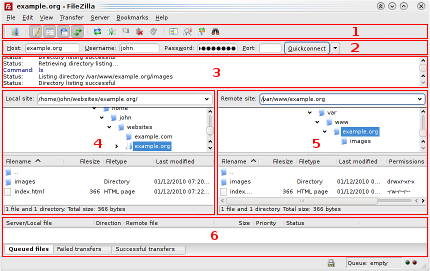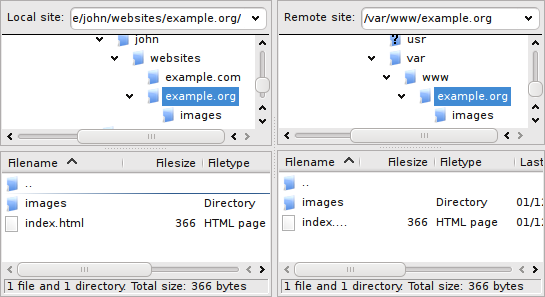FileZilla Client Tutorial (ca)
Aquest tutorial en altres llengües: English (English), Deutsch (German), Español (Spanish), Français (French)
Nota per a editors: Si us plau, llegiu aquesta nota de l'àmbit del tutorial abans d'afegir contingut.
Introducció:[edit]
Us donem la benvinguda al tutorial del Client FileZilla. En aquest tutorial, aprendreu a
- Connectar-vos a un servidor FTP,
- Descarregar i carregar fitxers,
- Utilitzar el gestor de llocs.
Si ja sabeu com utilitzar un client FTP, potser voldreu llegir unes instruccions d'ús més avançades.
Assumim que ja us heu instal·lat i engegat el Client FileZilla (instruccions d'instal·lació).
Connexió a un servidor[edit]
El primer que cal fer és connectar-se a un servidor.
Aquestes són les nostres dades (fictícies) - utilitzeu les vostres pròpies dades si voleu, alhora, seguir activament el tutorial.
Nom de l'amfitrió (Hostname): exemple.org Identificador d'usuari (username): josep Contrasenya (password): 7PjU#.J3
Utilitzarem la barra de connexió ràpida per a establir la connexió:
Anoteu el nom de l'amfitrió al camp de la barra de connexió ràpida Amfitrió: (Host:), l'identificador d'usuari al camp Nom d'usuari: (Username:) així com la contrasenya al camp Contrasenya: (Password:). Podeu deixar el camp Port: buit si no us l'han proporcionat amb les vostres dades. Ara ja podeu clicar a Connexió ràpida (Quickconnect).
Nota: Si la vostra informació d'accés especifica un protocol com SFTP o FTPS, anoteu el nom d'amfitrió així: sftp://amfitrio o ftps://amfitrio respectivament.
Ara, FileZilla provarà de connectar-se al servidor. Si tot funciona correctament, veureu que a la "columna" de la dreta canvia de No us heu connectat a cap servidor a mostrar-vos el llistat de fitxers i directoris.
[edit]

El següent pas és familiaritzar-vos amb el disseny de la finestra de FileZilla.
Aquí teniu una introducció ràpida: Sota de la barra d'eines (1) i de la barra de connexió ràpida (2), el registre de missatges (3) mostra els missatges de connexió i transferència. Sota, podeu trobar els llistats de fitxers. La columna esquerra (panell local, 4) mostra els fitxers i directoris existents al vostre dispositiu, és a dir, les coses que hi ha al PC en què utilitzeu FileZilla. La columna dreta (panell servidor, 5) mostra els fitxers i les carpetes existents al servidor al que us heu connectat. Ambdues columnes tenen un arbre de carpetes a dalt i un llistat detallat de la carpeta seleccionada en aquell moment a sota. Podeu navegar fàcilment per qualsevol dels arbres i llistes fent clic com en qualsevol altre gestor de fitxers. A la part inferior de la finestra, la "cua de transferència" (6) enumera els fitxers a transferir i els que ja s'han transferit.
Transferència de fitxers[edit]
Ara carregarem aquests fitxers (o qualsevol altre que trieu):
lloc_web/
+- index.html
+- imatges/
+- imatge01.jpg
+- imatge02.jpg
Carregant[edit]
Primer - in the local pane - bring the directory into view which contains data to be uploaded (e.g. index.html and images/). Now, navigate to the desired target directory on the server (using the server pane's file listings). To upload the data, select the respective files/directories and drag them from the local to the remote pane. You will notice that the files will be added to the transfer queue at the bottom of the window and soon thereafter get removed again - since they were (hopefully, if nothing went wrong) just uploaded to the server. The uploaded files and directories should now be displayed in the server content listing at the right side of the window.
Note: If you don't like using drag-and-drop, you can also right click on files/directories (in the lower local pane) and select Upload to upload them - or simply double-click a file entry (this does not work for directories).
Note (advanced): If you enable filtering and upload a complete directory, only the not-filtered-out files and directories inside this directory will be transferred.
Downloading[edit]
Downloading files, or complete directories, works essentially the same way as uploading - you just drag the files/directories from the remote pane to the local pane this time, instead of the other way round.
Note: In case you (accidentally) try to overwrite a file during upload or download, FileZilla will by default display a dialog asking what to do (overwrite, rename, skip...).
Using the site manager[edit]
Now that you are confident in transferring files (if not, practice a little bit), you might want to add the server information to the site manager to make it easy to reconnect to this server. To do this, select Copy current connection to Site Manager... in the File menu. The site manager will be opened and a new entry will be created with all the important information already filled in. You will notice that the entry's name is selected and highlighted - you can enter some descriptive name so you will later on find your server again (enter something like domain.com FTP server for example - you can rename it later if you wish). Now close the dialog by clicking on OK.
The next time you want to connect to this server, you can simply select it in the site manager and click Connect.
Conclusion[edit]
You should now be able to use the basic FileZilla features.
One final remark: Most tasks can be completed in several ways. The ways chosen for this tutorial are the most clear ones - if you invest a bit of time and just look around or read some of the advanced documentation, you will find much quicker ways to achieve what you want (there are toolbar buttons for often-used commands for example; some also react on right-clicking them).
If you feel reasonably confident by now, it might be worthwhile to also read the advanced usage instructions to learn about additional features not shown in this tutorial.
Further information[edit]
- Documentation: Documentation for the most important topics
- Site manager: Details about how to set up your sites in FileZilla
